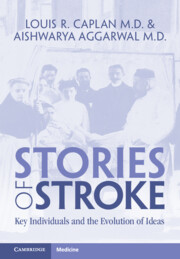Book contents
- Stories of Stroke
- Stories of Stroke
- Copyright page
- Contents
- Contributors
- Why This Book Needed to Be Written
- Preface
- Part I Early Recognition
- Part II Basic Knowledge, Sixteenth to Early Twentieth Centuries
- Chapter Four Andreas Vesalius
- Chapter Five William Harvey
- Chapter Six Thomas Willis
- Chapter Seven Giovanni Morgagni
- Chapter Eight Apoplexy
- Chapter Nine Atlases
- Chapter Ten Brainstem Syndromes
- Chapter Eleven Jules Dejerine
- Chapter Twelve Arterial and Venous Anatomy
- Chapter Thirteen Rudolf Virchow
- Chapter Fourteen Early Medical and Neurological Textbooks
- Part III Modern Era, Mid-Twentieth Century to the Present
- Part IV Stroke Literature, Organizations, and Patients
- Index
- References
Chapter Thirteen - Rudolf Virchow
from Part II - Basic Knowledge, Sixteenth to Early Twentieth Centuries
Published online by Cambridge University Press: 13 December 2022
- Stories of Stroke
- Stories of Stroke
- Copyright page
- Contents
- Contributors
- Why This Book Needed to Be Written
- Preface
- Part I Early Recognition
- Part II Basic Knowledge, Sixteenth to Early Twentieth Centuries
- Chapter Four Andreas Vesalius
- Chapter Five William Harvey
- Chapter Six Thomas Willis
- Chapter Seven Giovanni Morgagni
- Chapter Eight Apoplexy
- Chapter Nine Atlases
- Chapter Ten Brainstem Syndromes
- Chapter Eleven Jules Dejerine
- Chapter Twelve Arterial and Venous Anatomy
- Chapter Thirteen Rudolf Virchow
- Chapter Fourteen Early Medical and Neurological Textbooks
- Part III Modern Era, Mid-Twentieth Century to the Present
- Part IV Stroke Literature, Organizations, and Patients
- Index
- References
Summary
Toward the end of the eighteenth century, interest turned to thrombi found within vessels. Morgagni opined that most thrombi found within vessels at necropsy developed after death but that intravascular clotting could occur during life [1,2]. Baillie wrote in 1793 that “it was known to every person acquainted with the animal economy that the blood coagulated in the vessels of the living body” [1,3]. He called attention to clots that formed in vessels after ligatures were placed and within dilated arteries.
- Type
- Chapter
- Information
- Stories of StrokeKey Individuals and the Evolution of Ideas, pp. 93 - 98Publisher: Cambridge University PressPrint publication year: 2022

